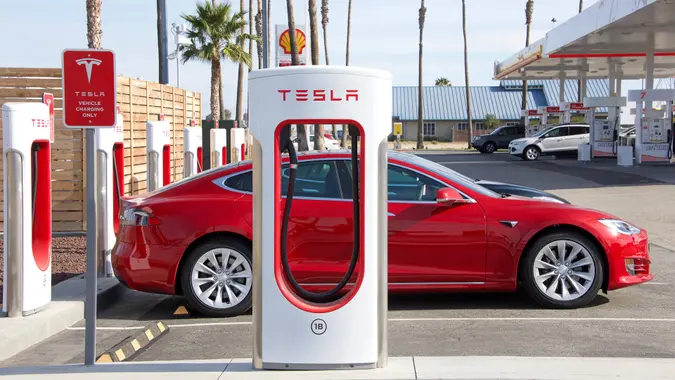Is Pay-Per-Mile Car Insurance Worth It? Guide To the Costs and Benefits

Commitment to Our Readers
GOBankingRates' editorial team is committed to bringing you unbiased reviews and information. We use data-driven methodologies to evaluate financial products and services - our reviews and ratings are not influenced by advertisers. You can read more about our editorial guidelines and our products and services review methodology.

20 Years
Helping You Live Richer

Reviewed
by Experts

Trusted by
Millions of Readers
The automotive insurance landscape is evolving, and one of the most intriguing options to emerge is pay-per-mile insurance. This model charges drivers based on the actual miles they drive, offering an alternative to traditional insurance plans. But is this type of policy right for you?
What Is Pay-Per-Mile Car Insurance?
Pay-per-mile insurance, often termed as “mileage-based” or “usage-based” insurance, offers coverage where premiums are determined by the actual distance you drive. Instead of a traditional flat rate, drivers are charged a base rate plus an additional fee for each mile driven.
How Does Pay-Per-Mile Car Insurance Work?
Depending on the method used to track mileage, the insurance company will calculate the monthly bill based on real-time statistics or reported mileage. For instance, a driver might pay a base rate of $30 plus $0.05 per mile. If the driver put 400 miles on the car that month, they would receive a bill for $50 that month.
To figure out how much to bill drivers, pay-per-mileage car insurance companies have a way to track mileage.
Insurance companies can use telematics, which are plug-in devices that can measure not just mileage, but things like speed and frequent breaking. Other companies use a GPS-based mobile app on your smartphone to track mileage.
Did You Know?
In the past, PPM car insurance providers would use odometer photos to track mileage.
Savings with Pay-Per-Mile Insurance
. This average rate was calculated based on a 35-year-old driver with good credit and no moving violations.
MarketWatch lists the average rate of pay-per-mile car insurance between six and eight cents per mile, with a monthly base rate between $20 and $35. Here’s how much drivers who put less than 1,000 miles per month on their car can save with PPM insurance, assuming a rate of seven cents a mile and a base rate of $30 per month.
| Mileage | Price | Per Month | Savings |
|---|---|---|---|
| 200 | $44 | $165 | $121 |
| 500 | $65 | $134 | $69 |
| 1,000 | $100 | $99 | -$1 |
Pros and Cons of Pay-Per-Mile Insurance
With pay-per-mile insurance, drivers have the potential to save money, especially if they don’t often use their vehicles. However, PPM insurance isn’t the lowest cost option for every driver and may have some drawbacks. Let’s explore the pros and cons.
Pros:
- Save money if you drive less than 10,000 miles per year
- Control your monthly insurance costs by changing your driving habits
- Encourages responsible, limited driving, which is better for the environment and traffic congestion
- More affordable for secondary or infrequently driven vehicles
- More affordable for people who work-from-home
Cons:
- May cost more than traditional insurance if you drive often
- Requires mileage tracking device or app
- Not available in all states or for all vehicle types
- May not offer comprehensive coverage
- Costs could spike if your situation changes (i.e., you return to the office after working from home)
- May not cover high-mileage events like road trips without added cost
Pay-Per-Mile Insurance vs. Traditional Car Insurance
| Feature | Pay-Per-Mile Insurance | Traditional Insurance |
|---|---|---|
| Pricing | Based on miles, plus the base rate | Flat monthly or six-month premium |
| Best for | Low-mileage drivers | High or average mileage drivers |
| Tracking | Required (via tech) | Not required |
| Availability | Limited by state and insurer | Widely available |
Companies That Offer Pay-Per-Mile Car Insurance
| Provider | Notable Features | Availability |
|---|---|---|
| Metromile | Popular pioneer in per-mile insurance; app-based | Available in select states |
| Mile Auto | No tracking device; uses odometer photos | Available in several U.S. states |
| Allstate Milewise | Offers a daily cap for high-mileage days | Available in many metro areas |
| Nationwide SmartMiles | Offers discounts and mileage forgiveness | Growing state availability |
Who Should Consider Pay-Per-Mile Insurance?
With pay-per-mile insurance, drivers have the potential to save money, especially if they don’t often use their vehicles. Remote workers, retirees who don’t take frequent road trips and tend to drive only around town, or people with short commutes may be ideal candidates for pay-per-mile insurance.
Drivers who have a “station car” that they use to drive short distances to a train or subway station to access public transportation, or have a second car that they don’t use often, may also save money with pay-per-mile insurance.
On the other hand, people with a lengthy daily commute or travelers who love road trips and travel long distances frequently could pay more with the pay-per-mile model. Gig workers who use their own vehicle for a rideshare or delivery service may not want pay-per-mile insurance, either.
How To Switch to Pay-Per-Mile Insurance
If you’re considering switching to a pay-per-mile policy, first spend a few months tracking your average monthly mileage to determine if it’s a good fit for you.
Get quotes from providers that offer pay-per-mile insurance plans. Remember to ask about the monthly flat rate and the per-mile fee. Compare these prices with what you’re currently paying for car insurance.
Make sure to evaluate coverage limit amounts and understand what’s covered to be sure you’re comparing similar policies. Some pay-per-mile plans don’t offer comprehensive coverage, which may be required if you lease your vehicle or have a car loan.
Finally, be sure you’re comfortable with the tracking device or app they want you to use. Once you write the policy, make sure you install or activate the required tracking method.
Consider pay-per-mile insurance if you:
- Don’t put more than 10,000 or so miles per month on your car
- Have a second vehicle you don’t drive frequently
- Would be willing to scale back your driving to save money
- Can budget for a one-time insurance increase if you drive more than usual one month
Final Thoughts
Car insurance is a critical component of driving, providing protection and peace of mind on the road. As the world changes and adapts, so does the world of insurance. They’re not for everyone though. Keep these tips in mind:
- Conduct a thorough car insurance analysis
- Consider your driving habits
- Know what you’re comfortable with before making a decision.
If you decide to make the change, compare offers and read provider reviews before you choose a company. In the end, the best policy is one that fits your lifestyle and needs.
Pay Per Mile Car Insurance FAQ
Here are answers to some frequently asked questions about getting pay per mile car insurance.- How does pay-per-mile car insurance work?
- Drivers who have a pay-per-mile car insurance policy track their mileage through photographs of odometers readings, a mobile app, or a telematics device installed in their car. They pay a flat monthly fee and then a cost per mile, which typically ranges from six to eight cents.
- Can I switch back to traditional insurance if my driving increases?
- You can switch back to a traditional insurance policy if you’ve had a pay-per-mile policy and your driving increases. Keep in mind you may have to pay a down payment for your new policy and also provide photos of your vehicle.
- What if I forget to track my miles?
- If you forget to track your miles for your pay-per-mile insurance, your provider might ask you to provide estimated mileage. If you overestimate, you might pay more than you should have. If you underestimate frequently, your provider may deny a claim or even drop your coverage. Fortunately, many pay-per-mile insurance companies provide a device you can install in your car to track mileage automatically.
- Is pay-per-mile insurance cheaper for most people?
- Pay-per-mile insurance may be cheaper for people who put less than 10,000 miles annually on their car, including remote workers, retirees, or people who need insurance for a second vehicle that’s not used often.
- Do I still get full coverage with a per-mile plan?
- Some pay-per-mile auto insurance companies do offer full coverage. One example is Mile Auto, which says it offers the same levels of liability, collision, and comprehensive coverage as other providers. You can also choose additional features like rental vehicle reimbursement and roadside assistance that you might get with a traditional insurance carrier.
- Will pay-per-mile insurance affect my credit score or driving record?
- Pay-per-mile insurance does not affect your credit score or driving record. However, as with traditional auto insurance, you might secure a lower rate with a good driving record and high credit score.
Our in-house research team and on-site financial experts work together to create content that’s accurate, impartial, and up to date. We fact-check every single statistic, quote and fact using trusted primary resources to make sure the information we provide is correct. You can learn more about GOBankingRates’ processes and standards in our editorial policy.
- MarketWatch. "Average Cost of Car Insurance."
 Written by
Written by  Edited by
Edited by 
























